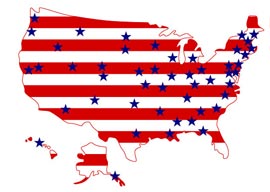
July 08, 2015

Source: Shutterstock
The concept of America being divided into sprawling red Republican regions and dense blue Democrat districts first became a cliché In November”December 2000. Over the past decade and a half I”ve probably thought as much about the underlying reasons as anybody, and in this column I”d like to speculate on an even more fundamental cause behind the red-blue divide.
Until 2000, the colors red and blue were not permanently associated with either American political party, in contrast to Britain, where the Socialists long flew the red flag of revolution, while the Tories had settled in response upon blue.
The main exception to the global standard of red equals left and blue equals right is the U.S., where both major parties prefer the full red, white, and blue panoply of the American flag. There was no consistent standard in the media until the 35-day dispute over who won the 2000 election, when it became habitual to map Republican states as red and Democratic states blue, with Florida purple.
The famous 2000 red-blue map revealed that a new electoral era had dawned, one whose gradual emergence had been temporarily obscured by Ross Perot’s third-party runs in 1992 and 1996. From 2000 through 2012, relatively little has changed in how the red-blue map is determined.
The red-blue map of the United States is particularly informative at the county level. For example, in 2012 Mitt Romney carried the vast majority of American counties, while still managing to lose the popular vote decisively.
That the partisan divide is related to density is clear. My contribution in 2004″05 was to point out that the red-blue map is related to affordability of family formation, a topic first explicated by Benjamin Franklin in the 1750s but largely ignored in recent decades. To illustrate how unexpected this revival of Franklinist thinking was, let me quote Columbia U statistician Andrew Gelman, author of the book Red State, Blue State, Rich State, Poor State, in 2008:
The article gives a new (to me) take on the red-state, blue-state paradox: the point that Republicans do well in lower-income states, even though they do better among richer voters. Sailer points out that the strong Republican states in the south and middle of the country have lower cost of living (which of course goes along with them being low income). But, more to the point, many of the rich, Democratic-leaning metropolitan have housing costs that are even more expensive. Sailer attributes some of this to what he calls the Dirt Gap”coastal cities such as NY, Boston, and LA are bounded by water which limits their potential for growth, as compared to inland cities such as Dallas or St. Louis: “The supply of suburban land available for development is larger in Red State cities, so the price is lower.”
The easier it is to afford a house with a yard in a decent public school district, the younger that white people will form legitimate families, and thus the more the party of family values will appeal. Thus, on a measure I discovered in 2004″the average years married among younger white women in a state”Mitt Romney took 23 of the 24 highest-ranked states, while Barack Obama won 25 of the 26 lowest-ranked states.
But perhaps there are even more fundamental reasons for the density divide. The central red vs. blue identity gap falls between the Core vs. the Fringe of American life: The Obama coalition is a crazy quilt of identity groups who can be held together only by stoking fear and loathing of Core Americans.
But paradoxically, Core Americans have always tended to push outward toward the geographic margins, “to light out for the territory ahead of the rest,” as Huckleberry Finn concludes. The core business of America, as historian Frederick Jackson Turner pointed out in 1893, has been settling frontiers, which he defined as regions of low population density. America’s relative lack of inhabitants was causally connected with its fame as the land of liberty.
To this day, the same process goes on with Republican-leaning Americans constantly developing new terrain on the far edges of metropolises.
A vague but fundamental difference, noted at least since the Roman satirists, is that low-density locales see man striving against nature, while high-density cities encourage man to compete more with man for higher status. The former competition tends to be relatively objective, while the latter is more subjective.
These distinctions shouldn”t be exaggerated, but they do map to some of the differences between red and blue America.
Different densities appeal to different personalities. For example, the frontier was always assumed to be where a man could be free from matronly tyranny, a major theme of American letters. Huckleberry Finn sums up that he’s headed for Oklahoma “because Aunt Sally she’s going to adopt me and sivilize me and I can”t stand it. I been there before.”